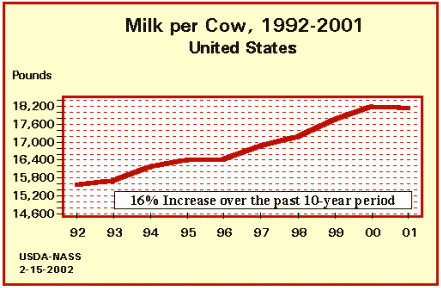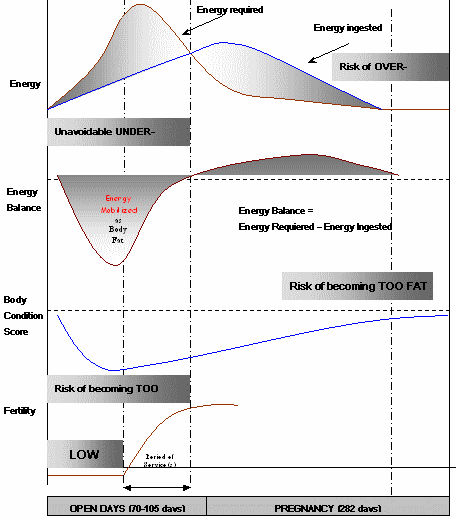Fats in the nutrition of dairy cows
Published: May 10, 2006
By: J. Ignacio Fernández. Agricultural Engineer - MBA - Norel & Nature Nutrición
Introduction
The production of milk per cow and lactation period has suffered a considerable increase in recent years. For example, according to data published by the USDA (1) (figure 1), the production per cow and lactation has increased 16% over the last ten years in the United States. This figure is even greater if we take into account data from other countries such as some European countries...

Figure 1. Production per cow and year in the last 10 years.
The use of genetic improvement programmes has accelerated this process and, in some cases, this increase in the level of production achieved has made the cows highly productive, true milk-producing machines. However, this great productive effort has made the animals very sensitive to a range of factors and any change in feeding, handling, etc has an immediate repercussion on milk production.
Another piece of relevant information that has accompanied this increase in production is the almost linear reduction in the fertility of the herds, which was 65 % at the beginning of the 80s and reached 44 % at the end of the 90s.
There has often been speculation on the possible effect that genetic selection has had on fertility, in which selection of the most productive animals also implied the selection of less fertile ones. However, when the production data for heifers that have been selected are analysed in comparison with others that have not been selected, it is seen that there are no differences in fertility. This suggests to us that it is not only the improvement in production but also other factors such as nutrition, also linked to an increase in production, that might play a key role in these low fertility rates associated with highly productive cows.
Certainly, if we stop to think about or closely analyse all the nutritional factors that can, in some way, influence the reproductive parameters, we would fill many pages with data on the effect of energy, protein, vitamin and mineral nutrition in fertility.
On this occasion, we will focus on energy, which is perhaps the most studied nutritional parameter, more specifically, we will focus on the most energetic nutrient, namely fat.
Milk production is a natural process that implies the use of energy for the highly productive dairy cow. During the first weeks of lactation, the energy needs increase exponentially, at the same time as milk production also undergoes such an increase. In this phase, the cow is not able to ingest sufficient energy to cover these needs, and so we enter what we denote the energy deficit phase or negative energy balance. The strategies for intensive dairy cattle management demand the maximisation of the yield of the cow and one of the ways of achieving this is to try to reduce as far as possible the costs associated with production, reduce the number of open days, reduce the number of AI, etc…. We should remember that the first moments of heat coincide with the stage of negative energy balance (Figure 2. adapted from M. Wattiaux) (2)
Female mammals have a mechanism by which, as seems logical, the production of milk takes precedence over reproduction. Thus, any energetic imbalance will penalise the reproductive parameters first rather than the productive ones, or at least will do so in a more important or significant degree.
In work by De Vries y Veerkamp (2000) (3), the authors concluded that for every 1.9 Mcal of NE of energy deficit per day, ovulation was delayed by one day. In this same work, a close correlation was found between the percentage of fat in the milk and the energy balance of the cow during the course of lactation. These investigators concluded that an indicator in the energetic balance could be the percentage of fat in the milk at the beginning of lactation. In practice, however, measurement of the energetic balance is not as easy as simply measuring the body condition that measures the state of fattening of the animal. Today, there are nutritional strategies during the early part of lactation aimed at ensuring that the loss of body condition is as small as possible.

Figure 2: Energy balance in dairy cows:
The Use of Fats may reduce the loss of Weight
As is well known, the most energetic nutrient is fat, which contains approximately 2.25 more energy than the carbohydrates. The use of fat in the feed of dairy cows is not new; the origins go back many years. A simplistic line of reasoning would justify the use of fats in dairy cows in order to provide a highly energetic source that, during the first months of lactation, would avoid excessive weight loss and consequently of body condition. Thus, from the first moment, most of the experiments performed with fat supplements were limited to studying its effect on the production and composition of milk. More recently, numerous publications have appeared (Staples and Burke 1998 (4), Staples and Thatcher 1990 (5), Lucy et al, 1992(6)) on how such supplementing can influence the reproductive parameters.
In all these reviews we arrive at the same conclusion. The fat not only exercises its positive effect on the reproductive parameters through the fact that it is an energy source, but also fat supplements, and more specifically, supplements with certain fatty acids, may activate or inhibit certain hormonal processes that have a direct effect on ovulation and/or maintenance of the embryo.
Fat, not only energy.
Just as protein nutrition does not limit us to the concept of protein, but rather we have to talk of amino acids, when talking of fats and above all the feed of monogastric animals, we talk more and more of fatty acids and maximum and minimum contains of these. Effects on the size of egg and the quality of the carcass have been studied and it is normal practice to set limits, whether they be minimum or maximum, for certain fatty acids (for example, linoleic acid C 18:2). In the feed of ruminants, we come across the drawback that, at a ruminal level, the profile of fatty acids ingested undergoes important changes due to hydrolysis and/or partial or total biohydrogenation in the rumen itself of the fats and fatty acids ingested.
What is the mechanism by which the addition of fatty acids may improve the fertility of the herd ?
In the reviews mentioned early, there are two important mechanisms by which addition of fat may improve the reproductive parameters.
One would be related to the improvement in the energetic status of the cow during the first part of lactation, as we have already seen, and the other would be the specific effect that the addition of fat and certain fatty acids has on the endocrine system. We will try to briefly review what are these specific effects.
The addition of fat to the rations of dairy cows resulted in an increase in the levels of progesterone in blood (Lucy et al, 1993)(7). Progesterone is synthesised by the corpus luteum and is responsible for the good implantation of the embryo in the uterus and helps to maintain gestation, providing the embryo with food.
There are two possible reasons for explaining the increase in progesterone in blood. On the one hand, it could be related to an increase in blood cholesterol and on the other, to a larger size of the follicles when the diet is supplemented with fat. It should be remembered that one of the precursors of progesterone is cholesterol. This is necessary for the formation of chylomicrons and, as a result, it increases naturally when the levels of fat in the ration are increased. The work of Grummer and Carrol (1990)(8), Moallem (1999)(9), Lucy (1993)(7), and several others showed this relationship between the higher level of fat in the diet and the increase in progesterone in plasma. But the level of cholesterol is not the only factor that could explain the increase in progesterone in plasma. Various works have shown a direct relationship between the addition of fat and the size of the follicles and, as a result, of the corpus luteum. The larger the size of the corpus luteum the greater the synthesis of progesterone.
As a second specific effect, the action of certain polyunsaturated fats has been shown by inhibiting or enhancing synthesis or release of different prostaglandins. Most of the positive results have been achieved with inert fats rich in unsaturated fatty acids, as, in ruminants, it would be the only way to guarantee that these fatty acids reach the tissues in which they exercise their effect.
The most important function of PGF2 alpha is that of re-establishing the oestrogen cycle as soon as birth has occurred, and until maintaining it until a new conception. PGF2 alpha allows the regression of the corpus luteum if the cow has not become pregnant. In this case, inhibition of PGF2 alpha has been associated with the direct effect not of the fat as such but rather with the effect of certain polyunsaturated fats. PGF2 alpha is an eicosanoid derived from arachidonic acid (20:4 n6), which is derived from the desaturation and elongation of linoleic acid (18:2 n6). Both acids of the n3 series (linolenic acid, eicosapentaenoic acid…) and those of the n6 series (linoleic acid, arachidonic acid…) compete for the unsaturated enzymes that intervene in the synthesis of eicosanoids. Therefore, it is to be expected that changes in the ratio of the two families of fatty acids produce changes in the synthesis of PGF2 alpha, which may have repercussions on different reproductive parameters. This has been shown in several papers by different authors (Filley et al., 2000(10); Cheng et al., 2001(11); Petit et al., 2002(12); Staples et al (6))
Once at this point, it seems proven that the addition of fat can, in different ways, improve the reproductive indices of cows and this will lead to a more profitable herd through reducing unproductive days. The effect is due not only to the amount of fat but also, as we have seen, to the type of fat, that is, the type of profile of fatty acids that comprise the diet. But, as we mentioned earlier, we should not forget that all fats firstly suffer lipolysis and then a ruminal biohydrogenation that extensively modifies the nature and profile of the fatty acids that reach the duodenum where they are absorbed.
To predict what the profile is of the fatty acids that leave the rumen when fats are provided in the form of free fatty acids is rather complicated. There are factors that condition what fatty acids will arrive at the duodenum and in what proportion. In a recent work by (Chalupa et al, 2001(13)) the authors present us with a submodel that tries to illustrate ruminal metabolism and intestinal digestion of the long-chain fatty acids. This work treats the different factors that might condition the type and quantity of fatty acids that reach the duodenum independently: the ingestion of fatty acids, ruminal lipolysis of the fat of the diet, ruminal biohydrogenation of fatty acids, synthesis of fatty acids at the ruminal level, the effect that fat has on ruminal digestion and fermentation and intestinal digestion of these fatty acids.
In conclusion, the use of fats in the feed of ruminants produces, in the majority of the cases, an improvement in the reproductive parameters that is due not only to a general improvement in body condition, but also to the specific effect that certain fatty acids have on the endocrine system and the secretion or inhibition of certain hormones related directly to reproduction. In order for these fatty acids to be able to exercise their function, they have to be absorbed at the intestinal level, and to ensure that this happens, we should guarantee that they reach the intestine without having undergone any alteration in the rumen. The solution seems to lie therefore in providing these fatty acids or this fat in protected form. Calcium soaps of palm oil is the product that has been most studied in this respect and in most cases, there is a positive but variable response in terms of improvement in fertility.
More data will be needed in the future in order to be able to evaluate more exactly what the effect is of these fatty acids, mainly polyunsaturated fatty acids, on the endocrine system. We should thus be able to optimise the use of fat supplements in cow feed.
References
1.- USDA – NASS - report 2/15/2002
2.- M. A. Wattiaux – Babcock Institute – University of Wisconsi – Madison – Technical Guides.
3.- De Vries and Veerkamp, 2000. J. Dairy Sci. 83: 62-69
4.- Staples, C.R., J.M. Burke and W.W. Thatcher. 1998. Influence of supplemental fats on reproductive tissues and performance of lactating cows. J Dairy Sci. 81:856
5.- Staples, C. R. and W. W. Thatcher, 1997. Interactions between energy and reproduction: today and tomorrow. Proc. Technical Dairy Simposium, Phoenix, AZ.
6.- Lucy, M. C., RC Staples, F.M., Michel and W. W. Thatcher. 1991, Effect of feeding calcium soaps to early postpartum dairy cows on plasma prostaglandin F2a, luteinizing hormone and follicular growth. J. Dairy Sci. 74:483-492.
7.-Lucy M.C. De La Sota. R.C. Staples and W. W. Thatcher, 1993. Ovarian follicular populations in lactating dairy cows treated with recombinat bobine somatotropin or saline and fed diets differing in fat content and energy. J. dairy Sci. 76:1014-1027
8.- Grumer and Carroll 1991. Effect of dietary fat on metabolic disorders and reproductive performance of dairy cattle. J. Animal Sci. 69:3838-3852.
9.- Moallem V, Y Folman, D. Sklan, 1999. Effect of Calcium soaps of fatty acids and administration of somatotropin on milk production preovulatory follicular development and plasma and follicular fluid lipid composition in high yield dairy cows. J. Dairy Sci.
10.- Filley SJ, Turner HA, Stormshak F. 2000. J Animal Sci. 78:139-144.
11.- Cheng, Z, Robinson R. S., Effect of dietary polyunsaturated fatty acids on uterine prostaglandin synthesis in the cow. The Journal of Endrocrinology. 171:463-73.
12.- Petit H. V., Dewhurst R.J., Scollan N.D., Milk production and composition, ovarian function, and prostaglandin secretion of dairy cows fed omega –3 fats.
13.- Chalupa W., Moate P. and Boston R. 2002. Scholl of Veterinarian Medicine. University of Pensilvania. 2
Related topics:
Recommend
Comment
Share
8 de enero de 2010
IT GIVES US IMMENSE PLEASURE THAT WITH THE INCLUSION OF FAT IN REGULAR FEED THE QUALITY OF THE MILK GOES HIGH AS A RESULT NOT ONLY THE USER FARMER ARE ALSO GETTING BENIFIT FROM THIS .
Recommend
Reply
7 de septiembre de 2009
The article gives a clean idea about the negative energy balance created in the transititon period. This negative energy, leads to postpartum complications like Retation of Placenta, Milk Fever & Ketosis.
The body score at the time of parturation help us to overcome post partum problems even help animal in initial phase of lactation & attening peak performane. It also helps animal to concive during first heat.
Recommend
Reply
Kemin Industries, Inc
8 de agosto de 2009
Its an excellent article.Use of inert fat is increasing on daily basis in diet of ruminants.
farmers are focusing on body score of their animals.It is helping in conditioning of animal in transition phase and enhancing reproductive performance,which is otherwise effected by high percentage of grians during transition phase.
Recommend
Reply

Would you like to discuss another topic? Create a new post to engage with experts in the community.









